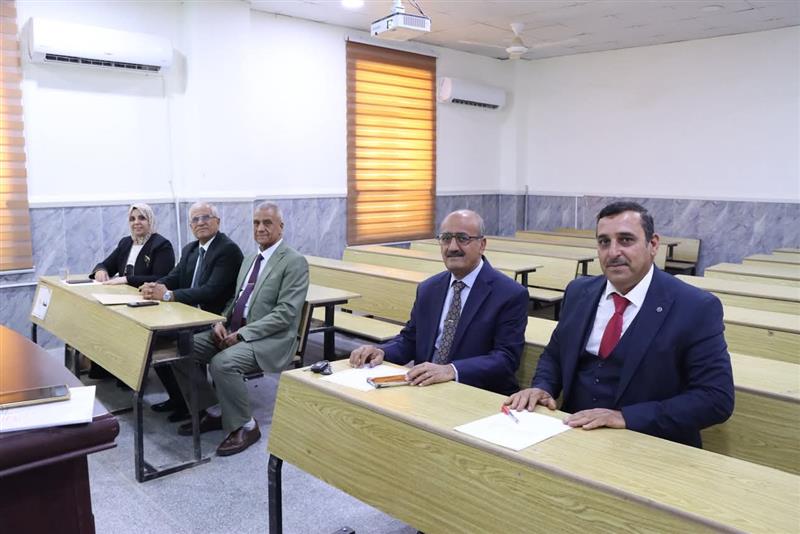
Medical Physics: Development and Applications
"Medical Physics: Development and Applications"
Rafaa Abdul Karim Abdul Wahed - Department of Medical Physics
Medical physics is a scientific discipline that aims to apply the principles and techniques of physics to improve health care through advanced diagnosis and treatment of diseases. This field originated in the late 19th century with the discovery of x-rays by Wilhelm Röntgen in 1895, which revolutionized the ability to see the internal structures of the human body without the need for surgical intervention. Since then, medical physics has expanded significantly to include a variety of technologies and innovations.
v The field of medical physics revolves around several main areas:
First, medical imaging, which is the use of various techniques such as X-rays, magnetic resonance imaging (MRI), ultrasound, and positron emission tomography (PET) to obtain detailed images of internal organs and tissues. These technologies play a vital role in diagnosing diseases accurately and quickly, allowing doctors to determine the most appropriate treatments for patients.
Second, radiotherapy, which is the use of radiation to treat diseases, especially cancer. This technique involves directing precise doses of radiation to destroy cancer cells while sparing the surrounding healthy tissue as much as possible. Radiotherapy techniques are constantly being developed and updated to improve their accuracy and effectiveness, reducing potential side effects.
Third, nuclear medicine, which involves the use of radioisotopes in diagnosis and treatment. By injecting or inhaling radioactive materials, the functions of organs and tissues can be precisely tracked and analysed, which helps in early detection of diseases and evaluation of the effectiveness of treatments.
Fourth, radiation protection, where medical physicists develop protocols and procedures to ensure the safety of patients and medical personnel from exposure to excessive radiation. These procedures include designing protective equipment and determining safe doses of radiation.
In short, medical physics combines science and technology to provide innovative medical solutions, which enhances the effectiveness of diagnosis and treatment and improves the overall quality of healthcare. This field is considered one of the basic pillars of modern medicine, as it constantly contributes to saving and improving the lives of millions around the world.
v The importance of studying medical physics
A. Improving the diagnosis of diseases: The study of medical physics helps in the development of advanced medical imaging techniques such as X-rays, magnetic resonance imaging (MRI), ultrasound, and positron emission tomography (PET). These technologies provide accurate and detailed images of internal organs and tissues, enabling doctors to diagnose diseases more accurately and quickly.
B. Developing effective therapeutic techniques: Medical physics plays a vital role in improving methods of treating diseases, especially cancer. Radiation therapy techniques, such as external beam radiation therapy and internal (brachytherapy) radiation therapy, use radiation to destroy cancer cells while sparing surrounding healthy tissue. Developing these technologies helps increase the effectiveness of treatments and reduce side effects.
C. Radiation Protection: Medical physicists deal with establishing protocols and procedures to ensure the safety of patients and medical personnel from excessive radiation exposure. This includes designing protective equipment and determining safe doses of radiation, which contributes to reducing the health risks associated with radiation.
D. Promoting research and innovation: Scientific research is an essential part of medical physics. Through research and development, medical physicists can improve understanding of the biological and physical processes that occur in the body, leading to the creation of new technologies and tools to improve health care.
E. Interdisciplinary Collaboration: Medical physics encourages collaboration between physicists, doctors, engineers, and scientists in different disciplines. This collaboration enhances the integration of knowledge and the development of comprehensive and innovative solutions to healthcare problems.
F. Improving the quality of life: By improving the accuracy of diagnosis and the effectiveness of treatment, medical physics contributes to improving the quality of life of patients. Advanced imaging and treatment technologies provide better opportunities for early detection of diseases and more effective treatment, which contributes to reducing suffering and increasing the chances of recovery.
v Conclusion
The importance of studying medical physics lies in its crucial role in improving medical diagnosis and treatment, protecting patients and workers, promoting scientific research and innovation, and cooperation between different specialties. Through continuous progress in this field, medical physics is contributing to improving healthcare and quality of life for patients around the world.




